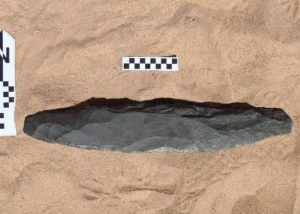Archaeologists have found a giant stone ax 250,000 years old

 During excavations in Saudi Arabia at the Al-Qurh archaeological site, archaeologists discovered a giant stone hand axe or biface, named for elongated fragments hewn and sharpened on both sides, resembling blades.
During excavations in Saudi Arabia at the Al-Qurh archaeological site, archaeologists discovered a giant stone hand axe or biface, named for elongated fragments hewn and sharpened on both sides, resembling blades.
Our ancestors used such tools to hold a chopper in their hands, to butcher animal carcasses, remove skins, and possibly even cut down trees.
The Middle Eastern artifact is 250,000 years old. However, it wasn’t the age that surprised archaeologists but rather the size—more than half a meter (1.6 ft). Only a giant could have used such a chopper, meaning a person significantly larger in size than ordinary individuals.
Archaeologists from Saudi Arabia aren’t making assumptions; they pledge to conduct further excavation, seeking other large tools to understand their intended purposes. It’s possible that further discoveries will shed light on who used these giant axes and the tasks they performed.
Scientists from the Institute of Archaeology at the University of California, Los Angeles (UCLA Institute of Archaeology), are also puzzled.
Recently, they found two giant stone axes during excavations on a hillside in the Medway Valley, Kent, England. The ‘English axes’ date back 300,000 years.
“At present, we don’t understand the purpose behind these large tools,” admitted Letty Ingrey, the archaeologist leading the excavations. She suggested that these huge axes might have symbolized something, such as strength or skill, rather than being used practically for their size.
Enthusiasts, inspired by the enormous tools of ancient people, consider them evidence supporting the existence of giants. They hint that the Middle Eastern giants were larger than the European ones, estimating them at 4 meters (13 ft) and even stretching the estimates to about 6 meters, basing this estimation on the size of their axes.




